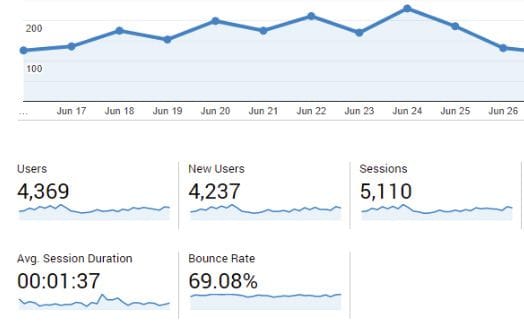Everything you need to know about bounce rates
)
If you are looking at your Google Analytics (and if you are not, then you definitely should be) you will see in your Audience Overview a figure - a percentage identified as "Bounce Rate."

What is bounce rate?
The definition is "the percentage of visitors to a particular website who navigate away from the site after viewing only one page."
Basically a user comes to your website, lands on a page and then leaves your website from that same page without clicking on anything else.
Your bounce rate shows you the percentage of your visitors who "bounce" off your site.
Bounce rate (%) = Visits that access only a single page (#) ÷ Total visits (#) to the website.
Why is bounce rate important?
Traditionally it has been known as an indication of whether your website is delivering the information that the user was looking for or if you have a high bounce rate you may not be encouraging visitors to continue with their visit and engaging them to delve deeper into your website.
Within Google Analytics you can look at your overall bounce rate in the Audience Overview. You can also look at your bounce rate by page or channels and you can go even further and look for it on mobile versus desktop.
What is a good bounce rate?
It is suggested as a rule of thumb that:
- 26%-40% is excellent
- 41%-55% is roughly average
- 56%-70% is higher than average but may not be cause for alarm depending on website
- 70% +- disappointing and worth looking into
Source: Rocketful
What are some of the reasons that your bounce rate may be high?
The number one reason for high bounce rates is when a visitor arrives on your site and decides the content on the page they're on isn't relevant or applicable to what they've searched for. Other reasons for high bounce rates include:
- Page speed - slow to load
- Low quality content
- Misleading Title Tag and or Meta Description
- Technical error - e.g. page not found
- Pop ups
- No CTA (call to action)
- External links open in same tab
- Referral spam
What to do about your bounce rate?
First step is to be looking at your Google Analytics so you know what your bounce rate is.
Then depending where it falls in the guidelines, and/or if you wish to improve, drill down further and investigate if it is particular pages, channels, devices etc.
Here at Bloomtools we recommend focusing on the pages with high traffic and high bounce rates first. Look at what you can do to improve that page to retain visitors longer, such as encouraging them to visit other pages on your website by including internal links in your content. If you're worried your content isn't modern or relevant, look at adding supporting facts, statistics and references to support your text. It's also important to make it visually appealing: add relevant images, break the text up into headings and subheadings, use bullet points and lists etc.
Here are some other suggestions of what to look at:
- Improve your content's readability
- Avoid pop ups - don't disrupt the UX (user experience)
- Create a compelling CTA (call to action)
- Improve your brand storytelling
- Keep your blog fresh with the right content
- Write attractive meta descriptions for search users
- Set external links to open in new windows
- Make sure your site is responsive
Need some help with your bounce rate?
If you would like to learn more about the bounce rate of your website and how to reduce it contact your local internet consultant at Bloomtools today.
) Author:Yvette Zocher
Author:Yvette Zocher| Tags:Website DesignSearch Engine Optimisation |
Check Out Our
Recent Articles
- Maximizing your Google Visibility: How to Choose the Right Google Busine...
- Why Put Energy Into Onboarding New Clients?
- Mastering Blog Success: A Comprehensive Guide to Crafting, Promoting, an...
- Unlocking the Power of Google Reviews - Without a Google email address
- Unlocking the Power of Trigger Emails: A Small Business Guide to Skyrock...



